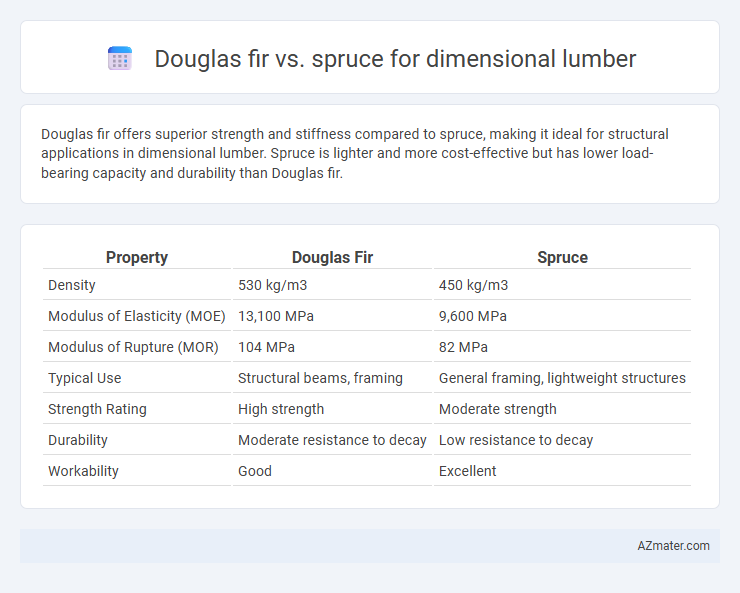Douglas fir offers superior strength and stiffness compared to spruce, making it ideal for structural applications in dimensional lumber. Spruce is lighter and more cost-effective but has lower load-bearing capacity and durability than Douglas fir.
Table of Comparison
| Property | Douglas Fir | Spruce |
|---|---|---|
| Density | 530 kg/m3 | 450 kg/m3 |
| Modulus of Elasticity (MOE) | 13,100 MPa | 9,600 MPa |
| Modulus of Rupture (MOR) | 104 MPa | 82 MPa |
| Typical Use | Structural beams, framing | General framing, lightweight structures |
| Strength Rating | High strength | Moderate strength |
| Durability | Moderate resistance to decay | Low resistance to decay |
| Workability | Good | Excellent |
Introduction to Douglas Fir and Spruce
Douglas Fir and Spruce are commonly used species for dimensional lumber, prized for their strength-to-weight ratio and structural reliability. Douglas Fir, known for its high stiffness, density, and durability, is frequently chosen in heavy construction and framing due to its superior load-bearing capabilities. Spruce offers lighter weight and ease of workability, making it suitable for projects requiring moderate strength and good availability in North American markets.
Botanical and Geographic Origins
Douglas fir (Pseudotsuga menziesii) is native to the western regions of North America, primarily found in the Pacific Northwest, including British Columbia, Washington, and Oregon, thriving in coastal and mountainous environments. Spruce, a genus primarily consisting of Picea species like Norway spruce (Picea abies) and Sitka spruce (Picea sitchensis), is predominantly distributed across the northern temperate and boreal zones of North America, Europe, and Asia, favoring cooler climates. The distinct botanical classifications and geographic origins influence the wood properties of Douglas fir and spruce, affecting their strength, density, and suitability for various dimensional lumber applications.
Physical Appearance and Grain Differences
Douglas fir features a reddish-brown hue with prominent, straight, and coarse grain patterns, creating a warm, rustic aesthetic ideal for visible structural elements. Spruce, on the other hand, offers a lighter, creamy white color with fine, uniform grain and fewer knots, resulting in a cleaner, more refined look suited for indoor millwork and finishing. The tighter grain of spruce contrasts with the more pronounced grain of Douglas fir, influencing both the visual appeal and the suitability for different woodworking projects.
Strength and Structural Performance
Douglas fir exhibits superior strength and structural performance compared to spruce when used for dimensional lumber, boasting a higher modulus of elasticity and greater bending strength. Its dense grain structure provides enhanced load-bearing capacity, making it ideal for heavy-duty framing and structural applications. Spruce is lighter and more flexible but generally offers lower strength values, which can limit its use in high-stress or heavily loaded structural components.
Workability and Ease of Use
Douglas fir offers superior workability for dimensional lumber due to its straight grain and moderate hardness, allowing for smooth cutting, shaping, and nailing without excessive wear on tools. Spruce, while lighter and softer, is easier to handle but may splinter more readily, requiring careful fastening and finishing. Both woods are commonly used, but Douglas fir is preferred for projects demanding higher strength and durability with efficient machining.
Durability and Resistance to Decay
Douglas fir offers superior durability and resistance to decay compared to spruce, making it a preferred choice for dimensional lumber used in structural applications exposed to moisture. Its dense grain structure and natural resin content provide enhanced protection against fungal attacks and insect damage. Spruce, while lighter and easier to work with, generally exhibits lower decay resistance, requiring careful treatment for outdoor or high-moisture environments.
Cost and Availability in the Market
Douglas fir dimensional lumber is generally more expensive than spruce due to its superior strength and durability, making it a preferred choice in construction despite the higher cost. Spruce is more widely available and often less costly, making it a budget-friendly option for projects with less stringent structural demands. Market availability of spruce tends to be more consistent, especially in North American and European regions, whereas Douglas fir supplies can fluctuate based on logging restrictions and regional demand.
Environmental Impact and Sustainability
Douglas fir offers superior environmental benefits compared to spruce due to its faster growth rate and higher carbon sequestration capacity, making it a more sustainable choice for dimensional lumber. Its dense grain and durability enable longer-lasting structures, reducing the need for frequent replacements and minimizing overall resource consumption. Spruce, while still renewable, typically grows slower and may require more intensive forest management practices, potentially increasing its environmental footprint.
Best Applications for Douglas Fir and Spruce
Douglas fir excels in structural applications such as framing, beams, and heavy timber construction due to its high strength, stiffness, and durability, making it ideal for load-bearing uses. Spruce, often combined with pine and fir in SPF lumber, is favored for general construction and interior finishes where moderate strength and lightweight material are required. Both species perform well in dimensional lumber, but Douglas fir's superior mechanical properties make it preferable for outdoor projects and heavy-duty framing, while spruce is cost-effective for non-structural or light framing tasks.
Conclusion: Choosing the Right Wood for Your Project
Douglas fir offers superior strength, durability, and consistent grain, making it ideal for structural applications in dimensional lumber, while spruce provides a lighter, more affordable option with sufficient strength for less demanding projects. When selecting wood, consider factors such as load-bearing requirements, environmental exposure, and budget constraints to ensure optimal performance and longevity. Opt for Douglas fir for heavy-duty framing and outdoor use, whereas spruce suits interior or non-structural components where cost-efficiency is prioritized.

Infographic: Douglas fir vs Spruce for Dimensional lumber
 azmater.com
azmater.com